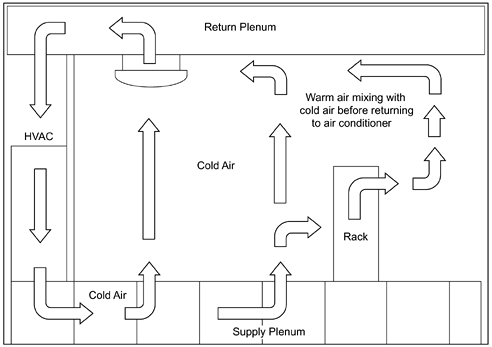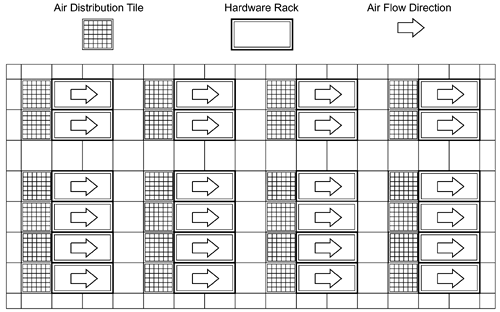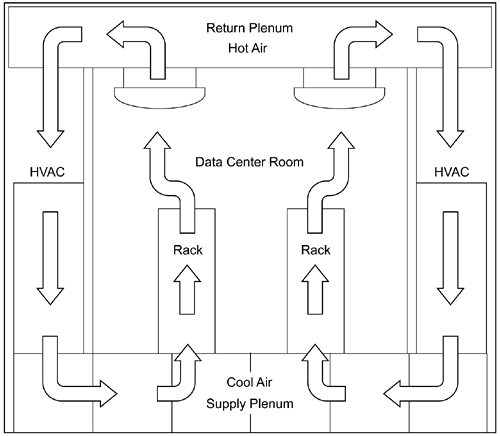| If you think of the controlled environment of a data center as a cocoon, it's easier to imagine how forced currents of air are heated and cooled in a continuous cycle. The basic principle of convection is what makes the system work: Cold air drops , hot air rises. The cycle of air flow in the room follows this basic pattern: -
Air is cooled as it passes through the air conditioning (HVAC) units. -
Conditioned air is forced into the raised floor void and directed up into the room and into equipment racks by means of tiles with perforations or cutouts . -
Conditioned air continues through equipment racks, cooling components . -
Heated air from components is forced out of the racks and rises toward the ceiling. -
Warm air is drawn back into the HVAC units where it is cooled and forced back into the raised floor to continue the cooling cycle. Tile Placement and Air Flow The modular design of the floor tiles that make up the equipment surface on a raised floor system are the building blocks for precise air distribution. The number and types of tiles necessary depend on specific characteristics of the site and the predetermined layout of the data center equipment. However, the following guidelines should be considered : -
Number of perforated tiles. Air conditioner manufacturers usually recommend a specific amount of opening in the floor surface in the form of air distribution tiles for each model of air conditioner they produce. The precise number of perforated tiles and where they will be placed must be determined by the location of heat-producing equipment. Floor tiles are typically 2 ft x 2 ft square. A typical 25 percent perforation tile represents one square foot of open area. -
Tile placement. Air distribution tiles should be positioned to deliver conditioned air to the intake of each rack. Solid tiles should be positioned to redirect air flow to the perforated tiles. -
Subfloor pressure. The subfloor pressure differential enables the efficient distribution of conditioned air. The pressure under the floor should be at least 5 percent greater than the pressure above the floor. Also, it might be necessary to adjust the number and position of perforated tiles to maintain appropriate pressure levels. It is the difference in pressure under the raised floor and above the raised floor that allows the cold air to flow correctly. Therefore, the pressure under the raised floor must be greater than the air pressure above the raised floor. You can use perforated tiles to modify this pressure change. Consider an example with two racks: The first, Rack A, is 20 feet from the HVAC unit. The second, Rack B, is 40 feet from the HVAC unit. The pressure under the floor at Rack A is x, and a 25 percent perforated tile provides an acceptable pressure differential to allow enough cold air to properly cool the machine. By the time the remaining air gets to Rack B, 20 feet further away, the pressure is x /2. To get the same amount of air to the machine when the air pressure is half, you need a 50 percent perforated tile, or two 25 percent perforated tiles right next to each other. -
Avoid air leaks. Unnecessary air leaks often occur through oversized cable cutouts or poorly cut partial tiles (against a wall, around a pillar , etc.). These breaches compromise the subfloor pressure and overall cooling efficiency. Fillers or protective trim should be fitted to these tiles to create a seal. -
Avoid cooling short cycles. Cooling short cycles occur when cold air from the air conditioner returns to the air conditioner before it has cycled through the heat-producing equipment. This happens when perforated tiles are placed between an air conditioner and the nearest unit of heat-producing hardware, as shown in FIGURE 8-6. Figure 8-6. Cooling Short Cycle Air Flow Patterns  Since cool air is being cycled back to the air conditioner, the regulating sensors at the return air intake will register a cooler room condition than is accurate. This will make the unit cycle out of cooling mode while the cooling needs of the equipment have not been addressed. This affects both temperature and relative humidity. -
Avoid subfloor obstructions. The subfloor is the path conditioned air travels to the machines, so everything should be done to minimize any obstructions in this path. In a perfect world, nothing should be in the subfloor but air. However, this is not always practical. Having power outlets and conduit above the subfloor will reduce obstructions, but it puts power cables in harm's way. The same is true with network cabling. However, you can take steps to reduce these obstructions. One way is to mount cable trays on the power conduit below the raised floor. Use cable trays that allow air to flow through them. If you are using patch panels on the floor or the POD design (see Chapter 9, "Network Cabling Infrastructure") you will have "home runs" of cables from areas on the floor back to the network room. Route these "home runs" through the ceiling rather than under the raised floor. Hardware Rack Placement The placement of hardware racks is dependent on several factors, including but not restricted to the following: -
Location of existing entryways and ramps -
Columns and other unavoidable obstructions -
Oddly shaped areas -
Aisles and other breaks in rack rows -
Available power connections -
Cooling requirements The last item in the list is the most common restricting factor. The heat load of small individual servers or storage arrays is generally low, but the density increases dramatically when the devices are stacked in racks. Also, newer technologies tend to condense the geometry of the electronics which thereby increase the density of the heat load. This is why it is important to determine the heat load based on RLUs (Chapter 4, "Determining Data Center Capacities"). The majority of Sun servers and storage arrays are designed to take in conditioned supply air at the front, pass it over the heat loads of the internal components, and exhaust it at the rear. Sun racks can house a wide variety of devices with differing air flow patterns. Some devices move air bottom to top, some from front to back, others from one side to the other. The front-to-back air flow pattern suggests a front-to-front (and back-to-back) row and aisle configuration as shown in FIGURE 8-7. With this configuration, direct transfer of the hot exhaust from one rack into the intake of another rack is eliminated. Figure 8-7. Suggested Front-to-Front Hardware Configuration  In this example, the aisle width is 4 feet (1.22 meters ), and the side-to-side spacing is virtually zero. Enough clearance should be maintained to allow any rack in the lineup to be removed for service or replacement. Note the breaks in the rows to allow easy access between rows. If, for some reason, the racks must be installed with the air flow going in the same direction, there must be adequate space between the aisles to avoid the direct transfer of hot exhaust from one rack into the intake of another rack, as shown in FIGURE 8-8. Figure 8-8. Alternate Front-to-Back Hardware Configuration  The amount of aisle space necessary will depend on the efficiency of the cooling system. If the cooling system and the possibilities for efficient air distribution are less than optimal, it might be necessary to increase the amount of aisle space, and possibly the space between the racks to spread out the heat load. In terms of rack spacing, consider the following: -
Aisle widths might be different depending on the size of the racks. Both the standard Sun storage rack and the Sun Fire 6800 server rack are two feet by four feet and would require a minimum of four feet (1.2 m) of aisle space. These widths could be different depending on tile and cutout placement. -
There must be breaks within the equipment rows to allow operators access between rows and to the backs of the racks. -
The design of the equipment rows should be based on local fire regulations. -
The air conditioning returns should be placed so that the warm air from the equipment has a clear path into them. In the case of a low ceiling, this is problematic as the warm air must build up until it can be drawn into the air conditioner intakes. A much better design implements a dropped ceiling with vents to allow warm air to rise up into the return plenum. From there, the hot air can be drawn efficiently back to the HVAC units. FIGURE 8-9 shows an efficient method of cycling the warm air back to the HVAC units located outside the data center walls through a return plenum. Figure 8-9. Cycling Warm Air Through a Return Plenum in the Ceiling  Subfloor Pressure Differential When conditioned air is forced into the subfloor void (plenum) it meets with resistance of the contained area which creates the subfloor pressure. This pressure builds up unless the air can find a way to escape. Escape routes are designed into the floor tiles in the form of cutouts and perforations in specific percentages, acting to distribute the cool air to the equipment in the room. The pressure is critical to the functioning of the equipment cooling system, and the pressure and air flow destinations can be controlled. This control is based on the following factors: -
The amount of air forced into the plenum (number of HVAC units and velocity). -
The distance the air must travel to get to the equipment it is meant to cool. -
Where air distribution tiles are placed in the room. (See the section "Tile Placement and Air Flow" on page 115 for more details.) -
The percentage of perforation in the placed air distribution tiles. (See the section "Tile Placement and Air Flow" on page 115 for more details.) -
Other breaches in the supply plenum, such as cable cutouts or missing tiles. (See the following section, "Supply Air Plenum Integrity," for more details.) The pressurization level must be adequate to move the right amount of cool air to the right parts of the data center. This pressure is regulated by the velocity of the air out of the HVAC units and the distribution and percentages of perforated tiles used. The pressurization levels in the plenum should be regularly monitored . This is especially important when any subfloor work must be done, because removing floor tiles will degrade subfloor pressure. Each 2 ft x2 ft solid tile represents 4 feet of floor area, equivalent to four perforated tiles with 25 percent perf. If many floor tiles must be removed for subfloor work, it might be necessary to compensate for lost pressure. Supply Air Plenum Integrity As emphasized in the previous section, the subfloor void in a downward-flow air conditioning system must be kept at an adequate pressure to properly cool equipment in the room above. The positive pressurization is created by initially introducing more air into the plenum than is allowed to escape into the data center room. To maintain the pressure and control the air flow, all breaches in the plenum must be intentional and part of the integrity of the air flow system. Unintentional breaches make planning the pressure levels difficult. To maintain the integrity of the supply air plenum, avoid the following: -
Too many air distribution tiles. The number of perforated tiles should be carefully determined to maintain proper pressurization. A typical 25 percent perforation tile represents one foot of free area. Higher perforation percentage tiles should be used with caution, because they limit air distribution adjustment. -
Oversized cutouts. Custom cutouts in tiles are typically for cable passage, to fit around support columns, and for other oddly shaped corners. Partial tiles are sometimes created to fill in around perimeter walls. The number of cutouts should be limited and carefully made. Oversized cutouts should be fitted with appropriate sealing trim or filled with closed- cell foam. -
Poor fitting tiles. Only tiles that accurately fit the support grid should be used. Replace any tiles that allow air to escape around the edges. Loose fitting partial tiles along any perimeter walls should be replaced or fit with trim to seal the gaps. -
Perimeter penetrations. Check for holes in the subfloor perimeter walls. These could be passages for cabling, conduit, or pipes and can constitute major leaks. Fill them with appropriate materials such as closed-cell foam. Seal any cracks or joints in perimeter walls and subfloor deck. Do not use any materials that might hinder the functioning of expansion joints. Fix any gaps between the perimeter walls and the structural deck or roof. -
Cable chases. Cable chases in PODs and into adjacent rooms can compromise air pressure in the subfloor. Holes in columns that route cable between subfloor plenum and ceiling plenum are a concern. The columns can act as chimneys depleting subfloor pressure and pressurizing the ceiling void. A pressurized ceiling void creates convection problems, diminishing the efficiency of the cooling system. -
Out-of-service HVAC units. If an HVAC unit is turned off for an extended period of time, the output should be blocked with an appropriate, non-shedding material. Left unblocked, subfloor pressure will force itself back through the unit. This not only drains pressure from the plenum, but the reverse air flow through the unit can dislodge particulate contaminants from the filters and force them into the supply air. Vapor Barrier Design and Conditions A vapor barrier is any form of protection against uncontrolled migration of moisture into the data center. It could be simply a matter of plugging holes, or it could mean retrofitting the structure of the data center to encapsulate the room. The added expense involved in creating an effective vapor barrier will be returned in greater efficiencies in the environmental support equipment. The following points should be considered to provide an effective vapor barrier: -
Avoid unnecessary openings. Open access windows , mail slots, etc., should not be a part of the data center design. These allow exposure to more loosely controlled surrounding areas. -
Seal perimeter breaches. All penetrations leading out into uncontrolled areas should be blocked and sealed. For more information, see "Supply Air Plenum Integrity" on page 121. -
Seal doorways. Doors and doorways should be sealed against unnecessary air and vapor leaks. Place high-efficiency gaskets and sweeps on all perimeter doors. -
Paint perimeter walls. Paint all perimeter walls from the structural deck to the structural ceiling to limit the migration of moisture through the building material surfaces. -
Seal subfloor area. Seal the subfloor to eliminate moisture penetration and surface degradation. The normal hardeners that are used in most construction will probably not be adequate to seal the subfloor. The procedure and additional materials for this process should be included in the building blueprints. |



